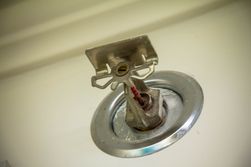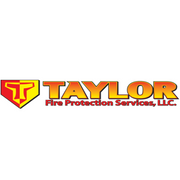How Do Fire Sprinkler Systems Work?

The American Fire Sprinkler Association estimates that a home fire occurs every 79 seconds in the U.S. House fires are tragic events that destroy property and lives; however, there are ways to limit the damage they cause. Sprinkler systems are remarkably effective at preventing damage, whether in office buildings or private residences. Since the 1960s, the U.S. government has required them in most building codes, but despite their ubiquity, you may not know how they work. The guide below details the mechanisms behind these invaluable systems.
The Basics of Fire Sprinkler Systems
Heat Activation
Thanks to movies and TV, many people believe sprinklers are smoke-activated. Fortunately, this isn’t true, and these systems have sophisticated safeguards to ensure they don’t activate spontaneously active and cause water damage.
This is accomplished through heat activation: Fires generate hot air that rises through the room and spreads along the underside of the ceiling, where it eventually reaches the sprinkler heads. Each head is connected to a glass bulb filled with glycerin-based liquid that expands when the air around it reaches 135 to 165 degrees Fahrenheit. As it expands, the glass breaks, triggering the sprinkler. Thus, unlike a smoke alarm, it takes more than a burned meal in the oven to set off the waterworks.
Targeted Sprays
 When one sprinkler in a building is activated, that doesn’t mean all of them are. Instead, each head must be triggered by heat through the process described above. This limits the amount of water damage to property—after all, what’s the point of saving possessions from fire if they’re ruined by water? Additionally, each sprinkler is designed to spray water down and outward in a pattern that will douse flames and prevent them from spreading to other locations.
When one sprinkler in a building is activated, that doesn’t mean all of them are. Instead, each head must be triggered by heat through the process described above. This limits the amount of water damage to property—after all, what’s the point of saving possessions from fire if they’re ruined by water? Additionally, each sprinkler is designed to spray water down and outward in a pattern that will douse flames and prevent them from spreading to other locations.
Different Systems for Different Situations
Not all sprinkler systems are the same; instead, they’re tailored to have the greatest efficacy for their environment. In office buildings and commercial sites, speed is among the most desirable qualities. Because of this, they use wet systems: The pipes are already filled with pressurized water that’s waiting to be released as soon as heat triggers it.
Museums and many residences, on the other hand, use systems that require two separate triggers: both smoke and heat. Those are also often dry systems, where the pipes are filled with air instead of water to ensure that leaks or low temperatures in winter won’t cause damage.
Are you seeking sprinkler systems, fire protection services, or smoke detectors around Wasilla, AK? Contact the expert staff at Taylor Fire Protection Services. With almost a century of combined experience, they work hard to provide the best safety measures possible for their clients, along with quality customer service that’s driven by values of integrity and professionalism. Learn more today by visiting them online or calling (907) 373-1760.
About the Business
Have a question? Ask the experts!
Send your question

